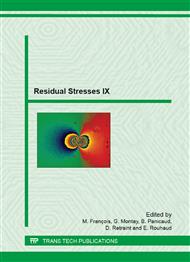[1]
H. Wohlfahrt, E. Macherauch, Die Ursachen des Schweißeigenspannungszustandes. Materialprüfung 19 (1977) 272-280. (In German).
DOI: 10.1515/mt-1977-190802
Google Scholar
[2]
T, Nitschke-Pagel, H. Wohlfahrt, Residual Stresses in Welded Joints - Sources and Consequences, Mater. Sci. Forum 404-407 (2002) 215-226.
DOI: 10.4028/www.scientific.net/msf.404-407.215
Google Scholar
[3]
H.K.D.H. Bhadeshia, Developments in Martensitic and Bainitic Steels: Role of the Shape Deformation, Mater. Sci. Eng. A378 (2004) 34-39.
Google Scholar
[4]
A. Ohta, O. Watanabe, K. Matsuoka, C. Shiga, S. Nishijima, Y. Maeda, N. Suzuki, T. Kubo, Fatigue Strength improvement by using newly developed low transformation temperature welding material, Welding in the World 43 (1999) 38-42.
DOI: 10.1080/09507110009549271
Google Scholar
[5]
F. Martinez Diez, Development of Compressive Residual Stress in Structural Steel Weld Toes by Means of Weld Metal Phase Transformations, Welding in the World 52 (2008) 63-78.
DOI: 10.1007/bf03266655
Google Scholar
[6]
J. Gibmeier, E. Obelode, J. Altenkirch, A. Kromm, T. Kannengiesser, Residual stress in steel fusion welds joined using low transformation temperature (LTT) filler material, Mater. Sci. Forum 768-769 (2014) 620-627.
DOI: 10.4028/www.scientific.net/msf.768-769.620
Google Scholar
[7]
C. Shiga, H.Y. Yasuda, K. Hiraoka, H. Suzuki, Effect of Ms temperature on residual stress in welded joints of high- strength steels, Welding in the World 54 (2010) 71-79.
DOI: 10.1007/bf03263490
Google Scholar
[8]
D. Thibault, P. Bocher, M. Thomas, M. Gharghouric, M. Côté, Residual stress characterization in low transformation temperature 13%Cr–4%Ni stainless steel weld by neutron diffraction and the contour method, Mater. Sci. Eng. A527 (2010) 6205-6210.
DOI: 10.1016/j.msea.2010.06.035
Google Scholar
[9]
R.J. Moat, H.J. Stone, A.A. Shirzadi, J.A. Francis, S. Kundu, A.F. Mark, H.K.D.H. Bhadeshia, L. Karlsson, P.J. Withers, Design of weld fillers for mitigation of residual stresses in ferritic and austenitic steel welds, Sci. Technol. Weld. Joi. 16 (2011).
DOI: 10.1179/1362171811y.0000000003
Google Scholar
[10]
A. Kromm, T. Kannengiesser, J. Altenkirch, J. Gibmeier, Residual Stresses in Multilayer Welds with Different Martensitic Transformation Temperatures Analyzed by High-Energy Synchrotron Diffraction. Mater. Sci. Forum 681 (2011) 37-42.
DOI: 10.4028/www.scientific.net/msf.681.37
Google Scholar
[11]
E. Macherauch, P. Müller, Das sin²ψ-Verfahren der röntgenographischen Spannungsmessung, Zeitschrift für angewandte Physik 13 (1961) 305-312. (in German).
Google Scholar


